CHECK ANY OTHER DTCS OUTPUT (IN ADDITION TO MISFIRE CODES)
READ VALUE USING INTELLIGENT TESTER (MISFIRE RPM AND MISFIRE LOAD)
READ VALUE USING INTELLIGENT TESTER (MISFIRE COUNT)
CHECK CYLINDER COMPRESSION PRESSURE
CHECK FUEL INJECTOR OF MISFIRING CYLINDER
CHECK FUEL INJECTOR OF MISFIRING CYLINDER
READ VALUE USING INTELLIGENT TESTER (COOLANT TEMP)
READ VALUE USING INTELLIGENT TESTER (COOLANT TEMP)
CHECK CYLINDER COMPRESSION PRESSURE
CHECK FUEL INJECTOR ASSEMBLY (POWER SOURCE)
CHECK HARNESS AND CONNECTOR (FUEL INJECTOR - ECM)
CHECK FUEL INJECTOR ASSEMBLY OF MISFIRING CYLINDER
CHECK WHETHER DTC OUTPUT RECURS
CHECK HARNESS AND CONNECTOR (MASS AIR FLOW METER - ECM)
CONFIRM WHETHER MALFUNCTION HAS BEEN SUCCESSFULLY REPAIRED
CHANGE TO CHANGE TO NORMAL SPARK PLUG AND CHECK SPARK OF MISFIRING CYLINDER
CHANGE TO NORMAL IGNITION COIL AND CHECK SPARK OF MISFIRING CYLINDER
DTC P0300 Random / Multiple Cylinder Misfire Detected
DTC P0301 Cylinder 1 Misfire Detected
DTC P0302 Cylinder 2 Misfire Detected
DTC P0303 Cylinder 3 Misfire Detected
DTC P0304 Cylinder 4 Misfire Detected
DTC P0305 Cylinder 5 Misfire Detected
DTC P0306 Cylinder 6 Misfire Detected
DTC P0307 Cylinder 7 Misfire Detected
DTC P0308 Cylinder 8 Misfire Detected
Description
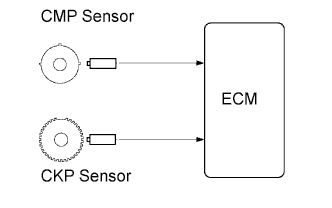 When the engine misfires, high concentrations of hydrocarbons (HC) enter the exhaust gas. Extremely high HC concentration levels can cause increases in exhaust emission levels. High concentrations of HC can also cause increases in the Three-Way Catalytic Converter (TWC) temperature, which may cause damage to the TWC. To prevent these increases in emissions and to limit the possibility of thermal damage, the ECM monitors the misfire rate. When the temperature of the TWC reaches the point of thermal degradation, the MIL blinks. To monitor misfires, the ECM uses both the Camshaft Position (CMP) sensor and the Crankshaft Position (CKP) sensor. The CMP sensor is used to identify any misfiring cylinders and the CKP sensor is used to measure variations in the crankshaft rotation speed. Misfires are counted as when the crankshaft rotation speed variations exceed predetermined thresholds.
If the misfire rate exceeds the threshold level, the ECM stores DTC(s).
When the engine misfires, high concentrations of hydrocarbons (HC) enter the exhaust gas. Extremely high HC concentration levels can cause increases in exhaust emission levels. High concentrations of HC can also cause increases in the Three-Way Catalytic Converter (TWC) temperature, which may cause damage to the TWC. To prevent these increases in emissions and to limit the possibility of thermal damage, the ECM monitors the misfire rate. When the temperature of the TWC reaches the point of thermal degradation, the MIL blinks. To monitor misfires, the ECM uses both the Camshaft Position (CMP) sensor and the Crankshaft Position (CKP) sensor. The CMP sensor is used to identify any misfiring cylinders and the CKP sensor is used to measure variations in the crankshaft rotation speed. Misfires are counted as when the crankshaft rotation speed variations exceed predetermined thresholds.
If the misfire rate exceeds the threshold level, the ECM stores DTC(s).
| DTC Code | DTC Detection Condition | Trouble Area |
| P0300 | Simultaneous misfiring of several cylinders occurs and one of the following conditions below is detected (2 trip detection logic):
|
|
| P0301 P0302 P0303 P0304 P0305 P0306 P0307 P0308 | Misfiring of a specific cylinder occurs and one of the following conditions below is detected (2 trip detection logic):
|
HINT:
When multiple DTCs for misfiring cylinders are stored, but DTC P0300 is not stored, it indicates that misfires have been detected in different cylinders at different times. DTC P0300 is only stored when several misfiring cylinders are detected at the same time.
Monitor description
The ECM stores a DTC when either one of the following conditions, which could cause emission deterioration, is detected (2 trip detection logic).
- Within the first 1000 crankshaft revolutions of the engine starting, an excessive misfiring rate (approximately 30 to 110 misfires per 1000 crankshaft revolutions) occurs once.
- An excessive misfiring rate (approximately 30 to 110 misfires per 1000 crankshaft revolutions) occurs a total of 4 times.
The ECM stores DTC(s) when either one of the following conditions, which could cause the Three-Way Catalytic Converter (TWC) damage, is detected (2 trip detection logic).
- At a high engine speed, a catalyst damage misfire, which monitored every 200 crankshaft revolutions, occurs once.
- At a normal engine speed, a catalyst damage misfire, which monitored every 200 crankshaft revolutions, occurs 3 times.
Wiring diagram
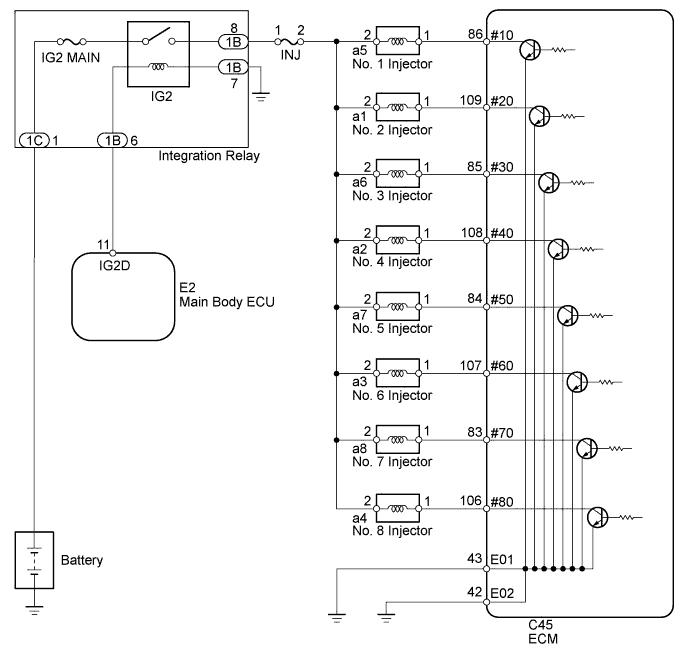

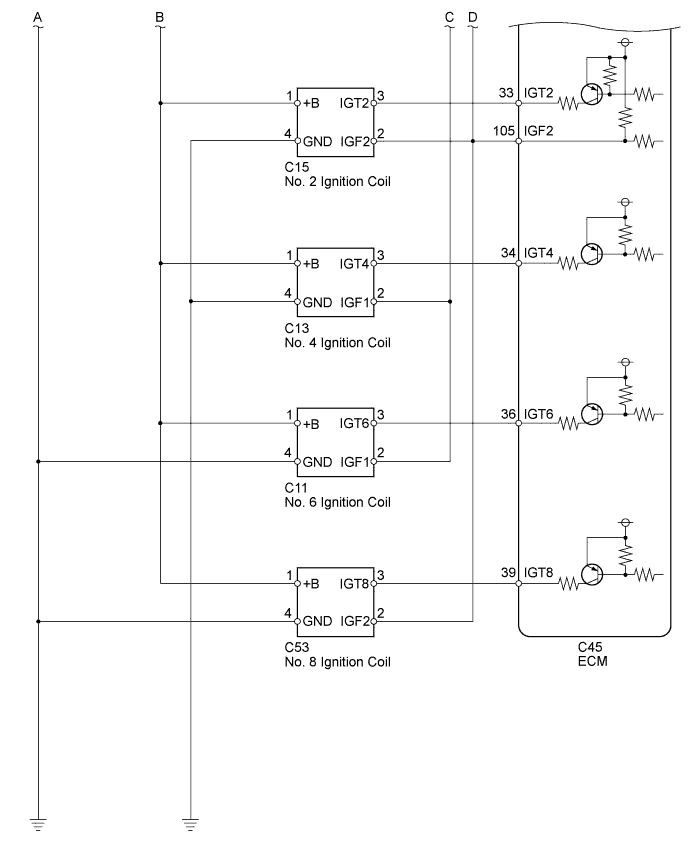
Confirmation driving pattern
- Connect the intelligent tester to the DLC3.
- Turn the engine switch on (IG).
- Turn the tester on.
- Record the DTC(s) and freeze frame data.
- Using the tester, switch the ECM from normal mode to check mode .
- Read the misfire counts of each cylinder (cylinder No. 1 to No. 8) with the engine in an idling condition. If any misfire count is displayed, skip the following confirmation driving pattern.
- Drive the vehicle several times with the conditions, such as engine speed and engine load, shown in Misfire RPM and Misfire Load in the Data List.
HINT:
In order to store misfire DTCs, it is necessary to operate the vehicle for the period of time shown in the table below, with the Misfire RPM and Misfire Load in the Data List.
Engine Speed Duration Idling 7 minutes or more 1000 4 minutes or more 2000 2 minutes or more 3000 1.5 minute or more - Check whether misfires have occurred by checking DTCs and freeze frame data.
HINT:
Do not turn the engine switch off until the stored DTC(s) and freeze frame data have been recorded. When the ECM returns to normal mode (default), the stored DTC(s), freeze frame data and other data will be cleared.
- Record the DTC(s), freeze frame data and misfire counts.
- Turn the engine switch off and wait for at least 5 seconds.
Inspection procedure
HINT:
- DTC P0300, P0301, P0302, P0303, P0304, P0305, P0306, P0307 and P0308 are for Euro-OBD only.
- If any DTCs other than misfire DTCs are output, troubleshoot those DTCs first.
- Read freeze frame data using the intelligent tester. Freeze frame data records the engine condition when malfunctions are detected. When troubleshooting, freeze frame data can help determine if the vehicle was moving or stationary, if the engine was warmed up or not, if the air-fuel ratio was lean or rich, and other data from the time the malfunction occurred.
- If the misfire does not recur when the vehicle is brought to the workshop, reproduce the conditions stored in the freeze frame data.
- If the misfire still cannot be reproduced even though the conditions stored in the freeze frame data have been duplicated, one of the following factors is considered to be a possible cause of the problem:
- The fuel level is low.
- Improper fuel is used.
- The spark plugs are dirty.
- After finishing repairs, check that no misfires occur in each cylinder (cylinder No. 1, No. 2, No. 3, No. 4, No. 5, No. 6, No. 7 and No. 8).
- Be sure to confirm that no misfiring cylinder DTCs are output again by conducting the confirmation driving pattern after the repairs.
- For 6 and 8 cylinder engines, the ECM intentionally does not store the specific misfiring cylinder DTCs at high engine speed. If misfires only occur during high engine speed driving, only DTC P0300 is stored.
In the event of DTC P0300 being present, perform the following operations:
- Clear the DTC .
- Start the engine and conduct the confirmation driving pattern.
- Read the misfiring rates of each cylinder or DTC(s) using the intelligent tester.
- Repair the cylinder(s) that has a high misfiring rate or is indicated by the DTC.
- After finishing repairs, conduct the confirmation driving pattern again, in order to verify that DTC P0300 is not output.
- When either Short FT #1, Long FT #1, Short FT #2 or Long FT #2 in the freeze frame data is outside the range of +/-20%, the air-fuel ratio may be rich (-20% or less) or lean (+20% or more).
- When the Coolant Temp in the freeze frame data is below 75°C (167°F), the misfires occurred only while warming up the engine.
- An extremely imbalanced drive wheel which causes body vibration may cause misfire DTCs to be detected.
| 1.CHECK ANY OTHER DTCS OUTPUT (IN ADDITION TO MISFIRE CODES) |
-
Connect the intelligent tester to the DLC3.
-
Turn the engine switch on (IG).
-
Turn the tester on.
-
Enter the following menus: Powertrain / Engine and ECT / DTC.
-
Read DTCs.
Result Result Proceed to P0300, P0301, P0302, P0303, P0304, P0305, P0306, P0307 and/or P0308 are output A P0300, P0301, P0302, P0303, P0304, P0305, P0306, P0307 and/or P0308 and other DTCs are output B
HINT:
If any DTCs other than P0300, P0301, P0302, P0303, P0304, P0305, P0306, P0307 and P0308 are output, troubleshoot those DTCs first.
|
|
||||
| A | |
| 2.CHECK PCV HOSE CONNECTIONS |
-
Check the PCV hose connections.
OK:
PCV hose is connected correctly and is not damaged.
|
|
||||
| OK | |
| 3.READ VALUE USING INTELLIGENT TESTER (MISFIRE RPM AND MISFIRE LOAD) |
-
Connect the intelligent tester the DLC3.
-
Turn the engine switch on (IG) and turn the tester on.
-
Enter the following menus: Powertrain / Engine and ECT / Data List / Misfire / Misfire RPM and Misfire Load.
-
Read and note the Misfire RPM and Misfire Load values.
HINT:
The Misfire RPM and Misfire Load values indicate the vehicle conditions under which the misfire occurred.
| NEXT | |
| 4.READ VALUE USING INTELLIGENT TESTER (MISFIRE COUNT) |
-
Connect the intelligent tester to the DLC3.
-
Turn the engine switch on (IG).
-
Turn the tester on.
-
Clear DTCs .
-
Enter the following menus: Powertrain / Engine and ECT / Data List / Misfire / Cylinder #1 Misfire Count, #2, #3, #4, #5, #6, #7 and #8.
-
Allow the engine to idle.
-
Read each value for Cylinder #1 Misfire Count to #8 displayed on the tester. If no misfire counts occur in any cylinders, perform the following procedures:
-
Move the shift lever to D.
-
Check the Cylinder #1 Misfire Count to #8.
-
If misfire counts are still not displayed, perform procedure "A" and "B" and then check the misfire counts again.
-
-
Drive the vehicle with the Misfire RPM and Misfire Load noted in the "Read Value Using tester (Misfire RPM and Misfire Load)" procedures above (Procedure "A").
-
Read the Cylinder #1 Misfire Count to #8 or DTCs displayed on the tester (Procedure "B").
Result Misfire Count Proceed to Most misfires occur in only 1 or 2 cylinders A 3 cylinders or more have equal misfire counts B HINT:
- If it is difficult to reproduce misfires for each cylinder, check the Data List item called Misfire Margin. Try to find vehicle driving conditions that lower the Misfire Margin value. Values above 30% are considered normal.
- If the freeze frame data record of the ECT is below 75°C (167°F), the misfire may be detected only when the engine is cold.
- If the freeze frame data record of the Engine Run Time is below 120 seconds, the misfire may be detected immediately after the engine is started.
|
|
||||
| A | |
| 5.INSPECT SPARK PLUG |
-
Inspect the spark plug of the misfiring cylinder .
|
|
||||
| OK | |
| 6.CHECK FOR SPARKS AND IGNITION |
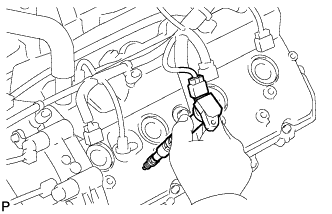
-
Disconnect the injector connectors to prevent the engine from starting.
CAUTION:
Always disconnect all injector connectors.
NOTICE:
Do not crank the engine for more than 2 seconds.
-
Remove the ignition coil from the cylinder head .
-
Install the spark plug onto the ignition coil.
-
Attach the spark plug assembly to the cylinder head.
-
Crank the engine for less than 2 seconds and check the spark.
OK:
Sparks jump across electrode gap.
-
Install the ignition coil.
-
Reconnect the injector connectors.
|
|
||||
| OK | |
| 7.CHECK CYLINDER COMPRESSION PRESSURE |
-
Measure the cylinder compression pressure of the misfiring cylinder .
|
|
||||
| OK | |
| 8.CHECK FUEL INJECTOR OF MISFIRING CYLINDER |
-
Check the injector injection [whether fuel volume is high or low, and whether injection pattern is poor] .
|
|
||||
| OK | |
| 9.CHECK HARNESS AND CONNECTOR |

-
Disconnect the fuel injector connector.
-
Disconnect the C45 ECM connector.
-
Measure the resistance according to the value(s) in the table below.
Standard Resistance:
Cylinder Tester Connection Condition Specified Condition No. 1 a5-1 - Body ground Always 10 k? or higher a5-1 - C45-86 (#10) Always Below 1 ? No. 2 a1-1 - Body ground Always 10 k? or higher a1-1 - C45-109 (#20) Always Below 1 ? No. 3 a6-1 - Body ground Always 10 k? or higher a6-1 - C45-85 (#30) Always Below 1 ? No. 4 a2-1 - Body ground Always 10 k? or higher a2-1 - C45-108 (#40) Always Below 1 ? No. 5 a7-1 - Body ground Always 10 k? or higher a7-1 - C45-84 (#50) Always Below 1 ? No. 6 a3-1 - Body ground Always 10 k? or higher a3-1 - C45-107 (#60) Always Below 1 ? No. 7 a8-1 - Body ground Always 10 k? or higher a8-1 - C45-83 (#70) Always Below 1 ? No. 8 a4-1 - Body ground Always 10 k? or higher a4-1 - C45-106 (#80) Always Below 1 ?
|
|
||||
| OK | |
| 10.CHECK FUEL INJECTOR OF MISFIRING CYLINDER |
-
Check the injector injection [whether fuel volume is high or low, and whether injection pattern is poor] .
|
|
||||
| OK | |
| 11.CHECK AIR INDUCTION SYSTEM |
-
Check the air induction system for vacuum leakage .
OK:
No leakage from air induction system.
|
|
||||
| OK | |
| 12.CHECK FUEL PRESSURE |
-
Check the fuel pressure .
|
|
||||
| OK | |
| 13.READ VALUE USING INTELLIGENT TESTER (COOLANT TEMP) |
-
Connect the intelligent tester to the DLC3.
-
Turn the engine switch on (IG).
-
Turn the tester on.
-
Enter the following menus: Powertrain / Engine and ECT / Data List / All Data / Coolant Temp.
-
Read the Coolant Temp twice, when the engine is both cold and warmed up.
Standard:
With cold engine:
Same as ambient air temperature.
With warm engine:
Between 75°C and 100°C (167°F and 212°F).
|
|
||||
| OK | |
| 14.INSPECT MASS AIR FLOW METER |
-
Connect the intelligent tester to the DLC3.
-
Turn the engine switch on (IG).
-
Turn the tester on.
-
Enter the following menus: Powertrain / Engine and ECT / Data List / All Data / MAF and Coolant Temp.
-
Allow the engine to idle until Coolant Temp reaches 75°C (167°F) or higher.
-
Read MAF with the engine speed at 3000 rpm.
Standard:
Between 25.2 gm/s and 35.2 gm/s (shift lever: N; A/C: Off).
|
|
||||
| OK | |
| 15.CHECK VALVE TIMING |

-
Remove the cylinder head cover LH and RH.
-
Turn the crankshaft pulley, and align its groove with the timing mark "0" of the timing chain cover.
-
Check that the timing marks of the camshaft timing gears and camshaft timing exhaust gears are at the positions shown in the illustration.
OK:
Timing marks on camshaft timing gears are aligned as shown in the illustration.
|
|
||||
|
|
||||
| 16.CHECK AIR INDUCTION SYSTEM |
-
Check the air induction system for vacuum leakage .
OK:
No leakage from air induction system.
|
|
||||
| OK | |
| 17.CHECK FUEL PRESSURE |
-
Check the fuel pressure .
|
|
||||
| OK | |
| 18.READ VALUE USING INTELLIGENT TESTER (COOLANT TEMP) |
-
Connect the intelligent tester to the DLC3.
-
Turn the engine switch on (IG) and turn the tester on.
-
Enter the following menus: Powertrain / Engine and ECT / Data List / All Data / Coolant Temp.
-
Read the Coolant Temp twice, when the engine is both cold and warmed up.
Standard:
With cold engine:
Same as ambient air temperature.
With warm engine:
Between 75°C and 100°C (167°F and 212°F).
|
|
||||
| OK | |
| 19.INSPECT MASS AIR FLOW METER |
-
Connect the intelligent tester to the DLC3.
-
Turn the engine switch on (IG).
-
Turn the tester on.
-
Enter the following menus: Powertrain / Engine and ECT / Data List / All Data / MAF and Coolant Temp.
-
Allow the engine to idle until Coolant Temp reaches 75°C (167°F) or higher.
-
Read MAF with the engine speed at 3000 rpm.
Standard:
Between 25.2 gm/s and 35.2 gm/s (shift lever: N; A/C: Off).
|
|
||||
| OK | |
| 20.CHECK VALVE TIMING |

-
Remove the cylinder head cover LH and RH.
-
Turn the crankshaft pulley, and align its groove with the timing mark "0" of the timing chain cover.
-
Check that the timing marks of the camshaft timing gears and camshaft timing exhaust gears are at the positions shown in the illustration.
OK:
Timing marks on camshaft timing gears are aligned as shown in the illustration.
|
|
||||
| OK | |
| 21.INSPECT SPARK PLUG |
-
Inspect the spark plug of the misfiring cylinder .
|
|
||||
| OK | |
| 22.CHECK FOR SPARKS AND IGNITION |

-
Disconnect the injector connectors to prevent the engine from starting.
CAUTION:
Always disconnect all injector connectors.
NOTICE:
Do not crank the engine for more than 2 seconds.
-
Remove the ignition coil from the cylinder head .
-
Install the spark plug onto the ignition coil.
-
Attach the spark plug assembly to the cylinder head.
-
Crank the engine for less than 2 seconds and check the spark.
OK:
Sparks jump across electrode gap.
-
Install the ignition coil.
-
Reconnect the injector connectors.
|
|
||||
| OK | |
| 23.CHECK CYLINDER COMPRESSION PRESSURE |
-
Measure the cylinder compression pressure of the misfiring cylinder .
|
|
||||
| OK | |
| 24.CHECK FUEL INJECTOR ASSEMBLY (POWER SOURCE) |
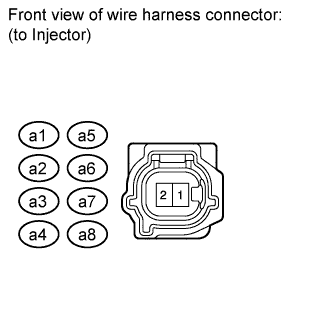
-
Disconnect the fuel injector connector.
-
Measure the voltage according to the value(s) in the table below.
Standard Voltage:
Cylinder Tester Connection Switch Condition Specified Condition No. 1 a5-2 - Ground Engine switch on (IG) 11 to 14 V No. 2 a1-2 - Ground Engine switch on (IG) 11 to 14 V No. 3 a6-2 - Ground Engine switch on (IG) 11 to 14 V No. 4 a2-2 - Ground Engine switch on (IG) 11 to 14 V No. 5 a7-2 - Ground Engine switch on (IG) 11 to 14 V No. 6 a3-2 - Ground Engine switch on (IG) 11 to 14 V No. 7 a8-2 - Ground Engine switch on (IG) 11 to 14 V No. 8 a4-2 - Ground Engine switch on (IG) 11 to 14 V
|
|
||||
| OK | |
| 25.CHECK HARNESS AND CONNECTOR (FUEL INJECTOR - ECM) |

-
Disconnect the fuel injector connector.
-
Disconnect the C45 ECM connector.
-
Measure the resistance according to the value(s) in the table below.
Standard Resistance:
Cylinder Tester Connection Condition Specified Condition No. 1 a5-1 - Body ground Always 10 k? or higher a5-1 - C45-86 (#10) Always Below 1 ? No. 2 a1-1 - Body ground Always 10 k? or higher a1-1 - C45-109 (#20) Always Below 1 ? No. 3 a6-1 - Body ground Always 10 k? or higher a6-1 - C45-85 (#30) Always Below 1 ? No. 4 a2-1 - Body ground Always 10 k? or higher a2-1 - C45-108 (#40) Always Below 1 ? No. 5 a7-1 - Body ground Always 10 k? or higher a7-1 - C45-84 (#50) Always Below 1 ? No. 6 a3-1 - Body ground Always 10 k? or higher a3-1 - C45-107 (#60) Always Below 1 ? No. 7 a8-1 - Body ground Always 10 k? or higher a8-1 - C45-83 (#70) Always Below 1 ? No. 8 a4-1 - Body ground Always 10 k? or higher a4-1 - C45-106 (#80) Always Below 1 ?
|
|
||||
| OK | |
| 26.CHECK FUEL INJECTOR ASSEMBLY OF MISFIRING CYLINDER |
Check the fuel injector injection [whether fuel volume is high or low, and whether injection pattern is poor] .
|
|
||||
| OK | |
| 27.CHECK HARNESS AND CONNECTOR |
-
Check the connection and terminal contact pressure of connectors and wire harnesses between the mass air flow meter and ECM .
HINT:
Repair any problems.
| NEXT | |
| 28.CHECK WHETHER DTC OUTPUT RECURS |
-
Connect the intelligent tester to the DLC3.
-
Turn the engine switch on (IG).
-
Turn the tester on.
-
Clear the DTCs .
-
Turn the engine switch off.
-
Turn the engine switch on (IG) and turn the tester on.
-
Start the engine and warm it up.
-
Drive the vehicle in accordance with the driving pattern described in Confirmation Driving Pattern.
-
Enter the following menus: Powertrain / Engine and ECT / Utility / All Readiness.
-
Input the DTC: P0300, P0301, P0302, P0303, P0304, P0305, P0306, P0307 or P0308.
-
Check the DTC judgment result.
Result Display (DTC Output) Proceed to ABNORMAL (P0300, P0301, P0302, P0303, P0304, P0305, P0306, P0307 or P0308 output) A NORMAL (No DTC output) B
|
|
||||
| A | |
| 29.CHECK HARNESS AND CONNECTOR (MASS AIR FLOW METER - ECM) |
-
Disconnect the mass air flow meter connector.
-
Disconnect the ECM connector.
-
Measure the resistance according to the value(s) in the table below.
Standard Resistance:
Tester Connection Condition Specified Condition C50-3 (VG) - C45-74 (VG) Always Below 1 ? C50-2 (E2G) - C45-75 (E2G) Always Below 1 ? C50-3 (VG) or C45-74 (VG) - Body ground Always 10 k? or higher
|
|
||||
| OK | |
| 30.REPLACE MASS AIR FLOW METER |
Replace the mass air flow meter assembly .
HINT:
If the results of the inspections performed in steps 14 and 21 indicated no problem, proceed to the next step without replacing the mass air flow meter assembly.
| NEXT | |
| 31.CONFIRM WHETHER MALFUNCTION HAS BEEN SUCCESSFULLY REPAIRED |
-
Connect the intelligent tester to the DLC3.
-
Turn the engine switch on (IG).
-
Turn the tester on.
-
Clear the DTCs .
-
Turn the engine switch off.
-
Turn the engine switch on (IG) and turn the tester on.
-
Start the engine and warm it up.
-
Drive the vehicle in accordance with the driving pattern described in Confirmation Driving Pattern.
-
Enter the following menus: Powertrain / Engine and ECT / Utility / All Readiness.
-
Input the DTC: P0300, P0301, P0302, P0303, P0304, P0305, P0306, P0307 or P0308.
-
Check the DTC judgment result.
Result Display (DTC Output) Proceed to NORMAL (No DTC output) A ABNORMAL (P0300, P0301, P0302, P0303, P0304, P0305, P0306, P0307 or P0308 output) B
|
|
||||
| A | |
|
| 32.CHANGE TO CHANGE TO NORMAL SPARK PLUG AND CHECK SPARK OF MISFIRING CYLINDER |
-
Change the installed spark plug to a spark plug that functions normally.
-
Perform a spark test.
CAUTION:
Always disconnect all injector connectors.
NOTICE:
Do not crank the engine for more than 2 seconds.
-
Install the spark plug to the ignition coil and connect the ignition coil connector.
-
Disconnect the injector connector.
-
Ground the spark plug.
-
Check if sparks occur while the engine is being cranked.
OK:
Sparks jump across electrode gap.
-
|
|
||||
| OK | |
|
| 33.CHANGE TO NORMAL IGNITION COIL AND CHECK SPARK OF MISFIRING CYLINDER |
-
Change the ignition coil to an ignition coil that functions normally.
-
Perform a spark test.
CAUTION:
Always disconnect all injector connectors.
NOTICE:
Do not crank the engine for more than 2 seconds.
-
Install the spark plug to the ignition coil and connect the ignition coil connector.
-
Disconnect the injector connector.
-
Ground the spark plug.
-
Check if sparks occur while the engine is being cranked.
OK:
Sparks jump across electrode gap.
-
|
|
||||
| OK | |
|
| 34.CHECK FUEL LINE |
-
Check the fuel lines for leaks or blockage.
|
|
||||
| OK | |
|